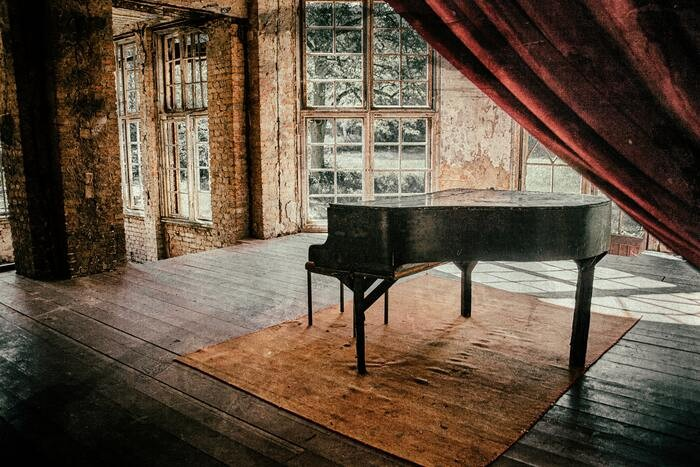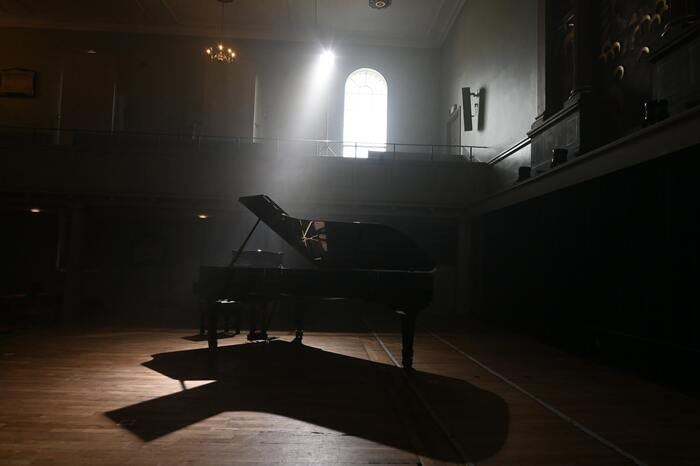When it comes to moving a baby grand piano, there are a few things you need to take into consideration. First, grand pianos are pretty heavy, even more so than large upright pianos, because most of the weight of any piano comes from its cast iron harp inside its body.
Most miniature grand piano starts at 54 inches long (equivalent to a 54-inch high upright piano at 500-600 lbs.) and can extend to 108 inches long for a nine ′ concert grand, topping out at 1000-1200 lbs. So grand pianos can weigh anywhere from 500 to 1200 lbs.
Most grand pianos are 4 1/2′ to 6’4” long, weighing between 500 and 800 lbs. But more extended grand pianos weigh much more and should be moved by professionals.

There are a few ways that you can move a baby grand piano. You can either have it driven by a professional mover, or you can move it yourself with the help of some friends or family members. If you decide to move it yourself, you will need to take into account the weight of the piano and the size of the piano. You will also need to make sure that you have enough space to move the piano around and that you have the proper equipment, such as a dolly or a moving truck.
Key Points
•Grand pianos are heavy, weighing between 500 and 1200 pounds.
• You can move a grand piano yourself with the help of friends or family, but you will need to consider the piano's weight and have the proper equipment.
• If you decide to move the piano yourself, follow some safety tips, such as lifting with your legs and not your back and having enough people to help carry it.
Components of Problems
While professional piano movers have the experience and know-how to move your baby grand piano successfully, they must still consider many potential problems, especially when steps are involved in the move. These problems, which include slippery surfaces, narrow stairs, curved staircases, doorways, and weather conditions, can make it difficult for even the most experienced mover. That's why it's always a good idea to have the piano mover visit the site before the moving day to determine what conditions may cause problems. By doing so, you can be sure that your baby grand piano will be moved safely and without incident.
Prepare For The Move
The first step is to remove all loose items from the piano, such as sheet music, books, candlesticks, etc. You’ll also want to cover the keyboard and other exposed surfaces with a soft cloth to protect them from scratches. Once the piano is prepped, you can start disassembling it. First, remove the legs and pedals.
You might need help with this step if the legs are particularly heavy or difficult to remove. Next, detach the lid from the body of the piano. Be careful with this step, as the top is fragile and can easily be damaged. Finally, remove the lyre, the metal frame that holds the strings in place. Once everything is disassembled, you can wrap each piece in blankets or moving pads for extra protection.
Tips On How To Do It Safely
If you decide to move your baby grand piano yourself, here are some tips on how to do it safely and efficiently:
1. Make sure you have enough space to move the piano around. Grand pianos are large and bulky, so you will need a lot of room to maneuver them. Make sure that there is plenty of space in your home or your driveway for the piano before you start trying to move it.
2. Get help from friends or family members. Moving a baby grand piano can be difficult and dangerous if done alone. Having at least one other person helping you lift and move the piano is recommended.
3. Use proper equipment. When moving any large object, it is essential to use the appropriate equipment for safety reasons. Make sure you have a dolly or a moving truck to help you safely and efficiently move the piano.
4. Take into account the weight of the piano. Grand pianos weigh quite a bit, so you must be physically strong enough to lift and move them around. Leaving and moving to the professionals is best if you don’t think you are strong enough.
5. Be careful when lifting and moving the piano. Grand pianos are extremely heavy and can cause serious injury if not handled properly. Please ensure everyone moving the piano knows how to lift and carry it safely. Never try to lift the entire weight of the piano by yourself – consistently distribute the weight equally between all of those helping out with the move.
What You Need to Know
If you're a musician or piano player, you know that moving a grand piano can be a huge hassle. They are big, heavy, and expensive, so you want to ensure it's done right. You need to consider a few things when moving a baby grand piano.
Weight and Size
Grand pianos are pretty heavy, even more so than large upright pianos. Most of the weight of any piano comes from its cast iron harp inside its body. Most miniature grand pianos start at 54 inches long and can extend to 108 inches for a nine ′ concert grand, topping out at 1000-1200 lbs. So grand pianos can weigh anywhere from 500 to 1200 lbs.
Most grand pianos are 4 1/2′ to 6’4” long, weighing between 500 and 800 lbs. But more extended grand pianos weigh much more and should be moved by professionals.
Prepare For the Move
When it comes to moving the piano, you have a few options. You can hire professionals to do it for you or try it yourself if you think you're up for the challenge. If you decide to move the piano yourself, be sure to have plenty of help and use proper equipment, such as straps and Dollies. And always remember - safety first!
It's essential to plan and contact a professional piano moving company well in advance. This will allow the movers to visit the site, assess potential problems, and ensure they have the appropriate experts available for the job. While most pianos can be moved without difficulty, baby grand pianos pose unique challenges. Their size and weight make them difficult to move, and their delicate components can be easily damaged. As a result, it's best to leave the job to the professionals. With proper planning and execution, your piano will arrive at its new home safe and sound.

Adjusting the Piano After the Move
As any musician knows, a piano is a delicate instrument. So when you move your baby grand piano to a new home, it's essential to take some time to let the instrument adjust to its new environment. This is because temperature and humidity changes can affect how a piano sounds.
Fortunately, there's an easy solution: get the piano tuned after you move it. This will help the piano acclimate to its new surroundings and sound best. And if you're concerned about your baby grand being a decoration more than a musical instrument, don't worry - it only takes a few weeks for a piano to adjust to a new home, so it'll be ready to play in no time.
Moving a baby grand piano is no small feat, but with the proper preparation, it can be done relatively quickly. They are big, heavy, and expensive instruments that must be handled carefully. Consider the piano's weight and size before attempting to move it yourself.
Having enough people to help carry the piano. Make sure to distribute the weight of the piano evenly between all the people carrying it, and take your time to avoid any injuries if you have a large grand piano. If you hire professionals, get multiple quotes and compare rates before making your final decision. They will have the experience and equipment necessary to move your piano safely. And most importantly - stay safe!
FAQ
How do I measure a baby grand piano?
The first step in moving a baby grand piano is to measure it. You need to know the dimensions of the piano, so that you can determine how much space you need to move it. The dimensions of a baby grand piano are typically 4'6" wide, 5'9" deep, and 3'2" high.
How do I lift my piano?
Pianos are heavy and unwieldy, so lifting them correctly is essential to avoid injury. For grand pianos, there are typically three people stealing – one on each end and one in the middle. For upright pianos, two people should lift from each end. When lifting, keep your back straight and use your legs rather than your lower back to do most of the lifting. Always be careful when moving a piano, as it can be challenging to control once off the ground.
What is the best way to transport my piano?
The safest way to transport a grand piano is by using a dolly. Upright pianos can usually be moved without a doll, but if you have one available, it’s always better to err on the side of caution. If you don’t have access to a dolly, you can use furniture sliders underneath each corner of the piano for an easier move. Make sure to secure your piano in the truck using straps or rope so that it doesn’t shift during transport and become damaged.
Reference
Xpress Movers
https://www.xpressmovers.com/blog/how-to-move-a-baby-grand-piano.php
3 Men Movers
https://www.3menmovers.com/how-to-move-a-baby-grand-piano/
Piano Movers of Texas
https://pianomoversoftexas.com/blog/move-piano-upstairs-downstairs/
